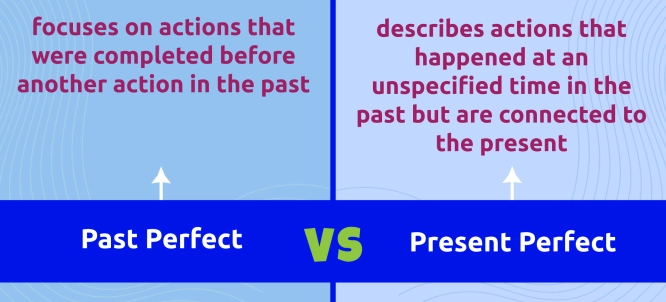by PushtoLearn
Present Perfect vs Past Perfect
Table of Contents
Present Perfect vs Past Perfect – Exercises
These exercises focus on Present Perfect vs Past Perfect
What is the Present Perfect?
The present perfect describes actions that happened at an unspecified time in the past but are connected to the present.
Rules for Present Perfect
-
Form: has/have + past participle
Examples of past participles: eaten, gone, played.
-
Use:
-
Actions that happened in the past but still affect now.
Example: "I have lost my keys." (I still don’t have them.)
-
Experiences up to now.
Example: "She has visited Paris." (At some time in her life.)
-
Recent actions with just.
Example: "They have just arrived."
Examples of Present Perfect
|
Subject |
Auxiliary Verb |
Past Participle |
Example Sentence |
|
I/We/You/They |
have |
finished |
We have finished our work. |
|
He/She/It |
has |
eaten |
He has eaten lunch. |

What is the Past Perfect?
The past perfect describes actions that happened before another action in the past. It shows the sequence of events.
Rules for Past Perfect
-
Form: had + past participle
-
Use:
-
Actions completed before another past action.
Example: "By the time we arrived, they had left."
-
Actions completed before a specific time in the past.
Example: "She had finished her homework before 8 PM."
Examples of Past Perfect
|
Subject |
Auxiliary Verb |
Past Participle |
Example Sentence |
|
I/You/He/She/It/We/They |
had |
seen |
I had seen the movie before they recommended it. |
Key Differences Between Present Perfect and Past Perfect
|
Feature |
Present Perfect |
Past Perfect |
|
Time Connection |
Connected to the present |
Connected to another past action |
|
Form |
has/have + past participle |
had + past participle |
|
Example |
"I have finished my homework." |
"I had finished my homework before dinner." |
Common Mistakes
-
Using present perfect with specific past times:
-
❌ "I have seen him yesterday."
-
✅ "I saw him yesterday."
-
Rule: Use past simple for specific times (e.g., yesterday, last year).
-
Confusing the order of events in past perfect:
-
❌ "When I arrived, the bus left."
-
✅ "When I arrived, the bus had left."
-
Rule: Use past perfect to show the earlier action (the bus leaving).
-
Mixing auxiliary verbs:
-
❌ "She have finished her meal."
-
✅ "She has finished her meal."
-
Rule: Use has for he/she/it.
Everyday Use
Present Perfect in Conversations:
-
"Have you ever been to Japan?"
-
"Yes, I have visited twice."
Past Perfect in Stories:
-
"When I got to the party, everyone had already left."
FAQ
When do I use present perfect instead of past simple?
Use present perfect for actions with no specific time or that affect the present. Use past simple for completed actions with a clear time reference.
Can I use 'had' in present perfect?
No, use "has" or "have" in present perfect. "Had" is for past perfect.
Why is 'just' used with present perfect?
"Just" emphasizes that the action happened very recently. Example: "I have just finished."
What are common present perfect signal words?
Common words include: already, ever, never, yet, just, and so far.
Do I always need another action for past perfect?
Usually, yes. The past perfect connects two past actions: one earlier, one later.

